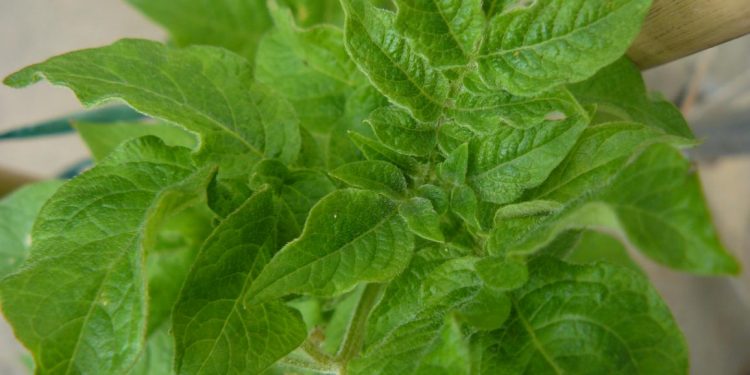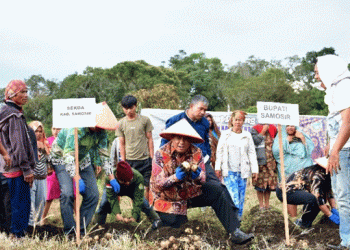The main virus species in many potato growing regions is Potato Virus Y (PVY).
Primary infection of PVY occurs in the growing season and is aphid-borne. The Peach-potato aphid, Myzus persicae, is considered the most efficient vector of PVY (i.e. it is more effective at transmitting PVY between potato plants than other aphid species). Winged forms of non-potato aphids such as cereal aphids can also be important in spreading the virus.
Secondary infection is tuber-borne.
Symptoms of primary infection can sometimes be seen but this probably varies with the variety, environment/season and timing of infection. Diseased (symptomatic) plants are generally the result of secondary transmission from infected tubers.
Symptoms include chlorotic mosaics in the haulm with possible pallor, leaf deformation, reduced leaflet size and overall reduction in vigour. Susceptible varieties could also produce smaller tubers with necrotic or dead rings on the skin.
Mixed infections are when a plant is infected by different virus species and this generates more severe symptoms (i.e. severe mosaic, stunting).
There are different strains and variants of PVY (e.g., PVYO, PVYC, PVYN, PVYNTN). These reflect differences that can be detected primarily according to their biology (e.g., the symptoms they cause), antibody-based detection methods like ELISA and using molecular techniques. More than one method is often needed to identify the viruses. It is generally accepted that isolates of the PVYN strain group cause milder mosaic symptoms on most potato cultivars than isolates of the PVYO strain group.
The strategy of control measures mainly relies upon the management of vectors and the use of pathogen-free seed potatoes. The elimination of sources of virus inoculum, such as volunteer potatoes and weeds such as nightshade and cape gooseberry, is very important (e.g., every 300-400 infected tubers per ha equates to an equivalent additional 1% increase in seed infection). Planting a non-host border crop around the potato crop about four weeks before planting, for example, wheat, oats, sorghum. This acts as a cleansing barrier for aphids. If PVY is entering the crop from an outside source then infective aphids may feed on the barrier crop, lose the virus and will no longer be infective when they land on the potato crop. Quick acting insecticides (pyrethroids, flonicamid, acetamiprid) would be preferred to slow acquisition of PVY from any infected plants and hinder flights to neighbouring non-infected plants. Some aphids (M. persicae, Sitobion avenae [Grain aphid]) that spread PVY are known to be resistant to pyrethroids. Mineral oils are used in mainland Europe/Canada to reduce virus transmission. They may be adjuvants to be applied with plant protection products (PPP) or in some cases paraffin oils are registered as PPP themselves. The mechanism of action of oils is not fully understood but it’s possible that oil on the aphid mouthparts reduces the acquisition and/or retention of PVY by the aphids. The number or frequency of mineral oil applications seem to be more important than the rate of each application. Overseas the focus is on the frequency of applications on young plants to protect leaves that are constantly developing. Field trials carried out in GB indicated that mineral oils can reduce virus transmission (up to a 2-fold (50%) reduction in the best-case scenario), but under high infectivity pressure (vector and virus source) may not always provide the necessary levels of prevention of virus infection for certified seed crops.
Photo: https://www.agric.wa.gov.au/








